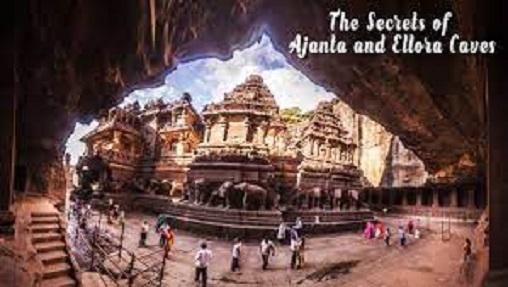Africa-Press – Lesotho. To the tourist in India a visit to the famous Ajanta and Ellora Caves is a must. If he is unconvinced of the glory that was India, that visit would be most revealing.
Situated about 300 miles from Bombay, these caves have become a place of pilgrimage to lovers of art from all over the world. If the Taj Majal is a poem in marble, the frescoes of Ajanta are the most perfect expressions of devotion to Buddhism.
Carved out of the mountain rocks with the chisel and hammer as the only tools, the monasteries and temples of Ellora stand as proud monuments of Indian sculpture at its zenith.
The Kailash Temple scooped out of a single rock is one of the most magnificent examples of what people animated by religious fervour can achieve. It is 184 feet in length, 109 feet in breadth and 98 feet in height.
The work started from the top to come to the bottom. On the outer walls are bas reliefs representing scenes from the Ramayan and Mahabharata. About 100 miles from Ellora are the now world-famous Ajanta caves of Buddhist origin. There are twenty-nine of them in all.
Situated in a crescent-shaped mountain among the wilds of the Hyderabad border infested with tigers, those caves were forgotten for ages until towards the end of the last century they were accidentally discovered by a British soldier who had lost his way in the jungle in a tiger hunt.
Today, Ajanta is a great tourist attraction. Thousands of people visit it every year. The caves which consist of monasteries and chapels and huge statues of Lord Buddha are among the greatest achievement of Buddhist art and among the greatest prides of India’s past glory.
The frescoes on the walls depicting the scenes from Lord Buddha’s life have preserved all their freshness even after two thousand years. According to experts, the antiquity of the caves has been placed between the 2nd century BC and the 7th century AD.
There are two things which impressed me most during my visit to the caves. One was a huge stone statue of the Buddha sitting in his usual posture so symbolical of a state of complete detachment and serenity.
If one looks at the face from a certain angle, the Buddha looks so defected that one wonders whether it was the same happy face that one had just seen from the front.
How the artist succeeded in giving two diametrically opposite moods to the same face is still puzzling my mind. The other thing which impressed me was the freshness of the frescoes. What substance went into the composition of the colour is a mystery even today.
Standing on the opposite bank of the stream which traverses the lovely glen where the caves are situated, one can perceive only small holes pierced into the rocks little sensing that inside those holes are to be found some of the greatest artistic treasures of India. As Buddhism is the religion of detachment, love, peace and self-abnegation leading ultimately to Nirvana, i. e.
, a state of eternal and sublime serenity and bliss, what better place could the Buddhist monks have chosen for their monasteries and chapels and chapels than the idyllic surrounding in the wilds of Ajanta? Could they have found any better place to mediate, to pray and to paint?
When I left Ajanta, I could not help expressing my regret that I could not enjoy for a longer time its serene atmosphere. I almost envied those monks who lived in those caves so many centuries ago. From ancient to modern India, it was not a far cry.
The next day after our visit to Ajanta and Ellora, we were at Poona visiting the Hindustan Antibiotics Laboratory where to combat the ills and sufferings of civilised man the Indian scientists and medical research workers were engaged in manufacturing penicillin and other antibiotics.
The scientists and their assistants form a small colony of their own. Their pay is attractive and every worker is provided with accommodation according to his job in the concern.
As we are living in an age where fear dominates our whole life and where most of our activities are directed towards the strengthening and consolidation of protective forces, our next call was inevitably at the National Defence Academy.
Major-General Halibullah, the Head of the Academy, who saw active service during the last war under Auchinleck, Wavell, Alexander and Montgomery proudly took us round the premises of the Academy after a lunch was solemnly served in true military tradition where rank and status were rigidly observed.
The Academy, which is the Indian equivalent of Sandhurst, recruits young men between the ages of 17 and 19 for training as cadets. They spend three years at the Academy following courses in such a wide variety of subject as Mathematics, Geography, Botany, Chemistry, Physics, Languages, etc.
The emphasis, however, General Halibullah told us, was on character formation. The three services, Navy, Army and Air Force, are combined and all the cadets follow the same courses.
After the three-year training, the trainees are diverted to their respective services for which they opt and the next stage is their intensive training for commission.
The National Defence Academy is built on an elevated plateau at the foot of the hill famous in history as the stronghold from where Shivaji routed the Moghul army and compelled the Moghul Emperor to make truce with him.
In that cool and quiet setting where everything is conducive to peace and calm, the young cadets pursue their training under the shadow of the memory of the great Shivaji, still the symbol of military courage and tenacity.
In the New India that is rising to greatness, the National Defence Academy is already a prominent institution. Those young men who will one day be entrusted with the defence of their motherland are taught not only how to fight for the country but also how to serve as examples of honesty, courage and loyalty.
Strange as it may seem, the spirit of Gandhiji is so strongly alive that even the armed forces in India cannot escape its influence. In order to accommodate Gandhism in the armed forced, a synthesis had to be evolved to avoid any possible conflict between the two.
Major-General Halibullah told us that his boys were also being trained to observe those two values which have been so dear to India throughout the ages: loyalty to truth and services to humanity.
For More News And Analysis About Lesotho Follow Africa-Press






